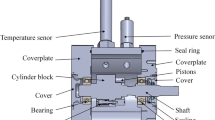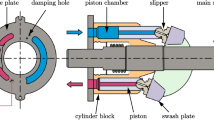Abstract
Axial piston pump with pre-compression volume(PCV) has lower flow ripple in large scale of operating condition than the traditional one. However, there is lack of precise simulation model of the axial piston pump with PCV, so the parameters of PCV are difficult to be determined. A finite element simulation model for piston pump with PCV is built by considering the piston movement, the fluid characteristic(including fluid compressibility and viscosity) and the leakage flow rate. Then a test of the pump flow ripple called the secondary source method is implemented to validate the simulation model. Thirdly, by comparing results among the simulation results, test results and results from other publications at the same operating condition, the simulation model is validated and used in optimizing the axial piston pump with PCV. According to the pump flow ripples obtained by the simulation model with different PCV parameters, the flow ripple is the smallest when the PCV angle is 13°, the PCV volume is 1.3×10−4 m3 at such operating condition that the pump suction pressure is 2 MPa, the pump delivery pressure 15 MPa, the pump speed 1 000 r/min, the swash plate angle 13°. At the same time, the flow ripple can be reduced when the pump suction pressure is 2 MPa, the pump delivery pressure is 5 MPa,15 MPa, 22 MPa, pump speed is 400 r/min, 1 000 r/min, 1 500 r/min, the swash plate angle is 11°, 13°, 15° and 17°, respectively. The finite element simulation model proposed provides a method for optimizing the PCV structure and guiding for designing a quieter axial piston pump.
Similar content being viewed by others
References
MANRING NOAH D, ZHANG Yihong. Valve-plate design for an axial piston pump at low displacement[J]. Journal of Mechanical Design, Transaction of the ASME, 2003, 125: 200–207.
IVANTYSYNOVA Monika, HUANG Changchun, CHRISTIANSEN Sven-kelana. Computer aided valve plate design-an effective way to reduce noise[J]. SAE International, 2004: 78–90.
MANRING NOAH D, DONG Zhilin. The impact of using a secondary swash-plate angle within an axial piston pump[J]. Journal of Dynamic Systems, Measurement And Control, 2004, 126: 67–74.
ERICSON Liselott. Measurement system for hydrostatic pump flow pulsations[D]. Linköping: Linköping University, 2005.
WANG Lin. Active control of fluid-borne noise[D]. Bath: University of Bath, 2008.
TIMO Nafz, HUBERTUS Murrenhoff, RUSIAN Rudik. Active systems for noise reduction and efficiency improvement of axial piston pumps[C]//Proceeding of Fluid Power and Motion Control, Bath: PTMC, 2008: 327–340.
PETTERSSON M E, WEDDFELT K G, PALMBERG J S. Methods of reducing flow ripple from fluid power pumps—a theoretical approach[J]. SAE Technical Paper Series, 1991, (911762): 1–10.
SEENIRAJ Ganesh Kumar, IVANTYSYNOVA Monika. Noise reduction in axial piston machines based on multi-parameter optimization[C]//Proceeding of 4th FPNI-PhD Symposium, Sarasota 2006: 235–246.
MEHTA Viral. Torque ripple attenuation for an axial piston swash plate type hydrostatic pump: noise consideration[D]. Columbia, University of Missouri-Columbia, 2006.
XU Bing, ZHANG Junhui, YANG Huayong, et al. Investigation on the radial micro-motion about piston of axial piston pump[J]. Chinese Journal of Mechanical Engineering, 2013, 26(2): 325–333.
ZHANG Bin, XU Bing, XIA Chunlin, et al. Modeling and simulation on axial piston pump based on virtual prototype technology[J]. Chinese Journal of Mechanical Engineering, 2009, 22(1): 84–90.
MA Jien. Study on Flow ripple and valve plate optimization of axial piston pump[D]. Hangzhou: Zhejiang University, 2009.
MA Jien, XU Bing, ZHANG Bin, et al. Study on flow ripple of axial piston pump with CFD simulation using compressible fluid oil[J]. Chinese Journal of Mechanical Engineering, 2010, 23(1): 45–52.
The International Organization for Standardization. ISO 10767-1-1996 Hydraulic Fluid Power-Determination of Pressure Ripple Levels Generated in System and Components Part 1: Precision method for pumps[S]. London: British Standards Institution, 1996.
PETTERSSON M E. Design of fluid power piston pumps with special reference to noise reduction[D]. Linköping: Linköping University, 1995.
Author information
Authors and Affiliations
Corresponding author
Additional information
This project is supported by National Key Technology R&D Program of the Eleventh Five-year Plan of China(Grant No. 2011BAF09B03), and National Natural Science Foundation of China(Grant No. 51075360)
XU Bing, born in 1971, is a professor at State Key Lab of Fluid Power and Mechatronic System, Zhejiang University, China. His main research interests include mechachonics engineering, fluid power element and system.
SONG Yuechao, born in 1981, obtained her PhD degree at Zhejiang University, China, in 2013. Her research interests include fluid power element.
YANG Huayong, born in 1961, is currently a professor and a PhD candidate supervisor at State Key Lab of Fluid Power and Mechatronic System, Zhejiang University, China. His main research interests include mechachonics engineering, fluid power transmission and control.
Rights and permissions
About this article
Cite this article
Xu, B., Song, Y. & Yang, H. Pre-compression volume on flow ripple reduction of a piston pump. Chin. J. Mech. Eng. 26, 1259–1266 (2013). https://doi.org/10.3901/CJME.2013.06.1259
Received:
Revised:
Accepted:
Published:
Issue Date:
DOI: https://doi.org/10.3901/CJME.2013.06.1259




